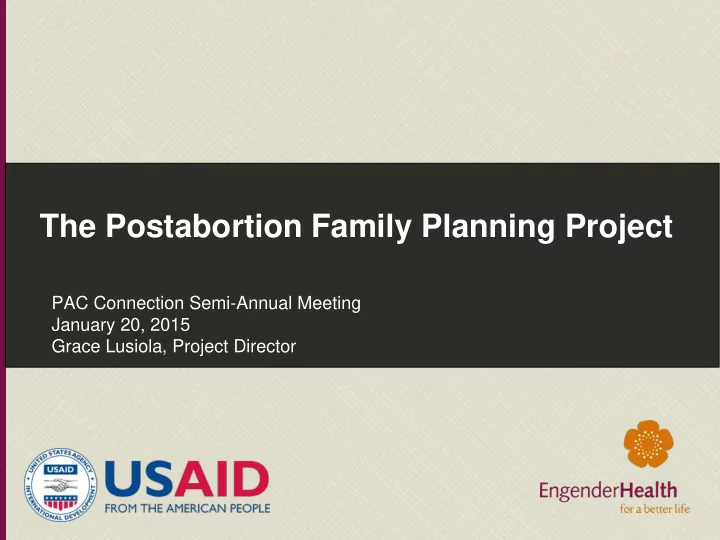

The Postabortion Family Planning Project PAC Connection Semi-Annual Meeting January 20, 2015 Grace Lusiola, Project Director
Outline • Background – Postabortion FP – Long-acting and permanent methods • The Postabortion Family Planning Project • Questions and discussion
Context Worldwide: • 40% of all pregnancies are unintended (75 million annually) • 47% of unintended pregnancies will end in an induced abortion (35 million annually) • 9% of maternal deaths are attributable to unsafe abortion (38,000 annually) Postabortion care is a critical opportunity to provide FP to women at high risk of a repeat unintended pregnancy and induced abortion . Sources: Darroch, J.E. and Singh, S., Adding It Up: The Costs and Benefits of Investing in Family Planning and Maternal and Newborn Health— Estimation Methodology, New York: Guttmacher Institute, 2011. and Sedgh G et al., Induced abortion: estimated rates and trends worldwide, Lancet , 2007, 370(9595):1338–1345.
Postabortion FP Postabortion FP is widely recognized as a priority: • 2013 joint consensus statement (FIGO, ICM, ICN, White Ribbon Alliance, USAID, BMGF) FP Counseling, Emergency I mmediately • USAID’s and other PAC models Provision; Treatment do.. Selected RH (STI ,HI V ) • USAID High Impact Practice • 2014 WHO-led research prioritization Community Empowerment through Community Awareness and Mobilization
Method matters The relative effectiveness of various methods at preventing pregnancy: No. of unintended pregnancies among 1,000 women in first year of Method typical use No method 400 Traditional Withdrawal 220 Female condom 210 Male condom 180 Short-acting Pill 90 Injectable 60 IUD (CU-T 380A/LNG-IUS) 8/2 Long-acting Female sterilization 5 and Vasectomy 1.5 permanent Implant 0.5 Source: Trussell J. Contraceptive Efficacy. In Hatcher RA, Trussell J, Nelson AL, Cates W, Kowal D, Policar M. Contraceptive Techology: Twentieth Revised Edition . New York NY: Ardent Media, 2011.
Method matters (continued) % of users continuing family planning methods at one year (worldwide) Tubal ligation ~100% Vasectomy ~100% Implants 87% IUD 84% Pill 51% Injectables 53% Periodic abstinence 54% Condoms 50% Source: Analyses of global DHS data, CYP update analyses under the RESPOND Project
Postabortion FP method mix in Tanzania PAC clients in Mwanza region, 2013 3000 Number of PAC clients 2500 2000 Condoms Pills 1500 Injectables IUD 87% 1000 Implant Female sterilization 500 0 PAC clients Counseled on Received a FP method Source: RESPOND Tanzania Project
The Postabortion Family Planning Project • Five year Cooperative Agreement awarded (2014 to 2019) • Ceiling of $5 million; $1 million each year • Purpose: accelerate reductions in maternal and newborn mortality with increased equity to end preventable child and maternal deaths • Objective: increase informed and voluntary postabortion use of LARCs/PMs. • To be implemented in Tanzania and up to two other countries • APS to coordinate closely with the Maternal Child Survival Project and other global projects
The Postabortion FP Project Model In established PAC programs will ... 1. Improve organization of PAC services to facilitate FP counseling and services prior to discharge from the facility ; 2. Strengthen FP services and referrals; improve method mix to include LARCs and/or referrals for PMs; 3. Facilitate logistics improvements to reduce stockouts; 4. Build policymaker, community, and client demand/support for postabortion FP; and 5. Address provider attitudes limiting delivery of postabortion FP.
Phased implementation approach: Phase I • Identify and establish model(s) to ensure delivery of FP counseling and services prior to discharge in existing PAC sites in each country • Provider training and supportive supervision in LARCs and, where there is enough demand, training in PMs • Begin implementation research, M&E, and documentation • Consider scale-up concerns and plan for scale-up
Phased implementation approach: Phase II • Provide TA, tools, and support to facilitate scale up in new districts • Document processes and outcomes
Phased implementation approach: Phase III • Support monitoring of sites • Ensure that learning informs institutionalization • Complete evaluation activities, create final toolkits, consolidate lessons learned • Disseminate findings, lessons, and tools at field and global levels • Advocate for/facilitate institutionalization of postabortion FP within partners.
Illustrative global activities beginning in Year One • Collaborate with the International Confederation of Midwives for competency-based FP training for midwifery tutors • Review the Global PAC Curriculum to determine how to include IUD and implant training • Review BEmONC Curricula for the inclusion of postabortion FP • Identify additional countr(ies) for implementation
Planned field activities Year One • Implement baseline study in Tanzania • Assess training needs • Begin trainings and supportive supervision for providers Future years • Build LARC service capacity • Strengthen referrals for permanent methods • Ensure availability of supplies and equipment • TA for demand creation and male involvement
Asanteni sana! Questions?
Recommend
More recommend